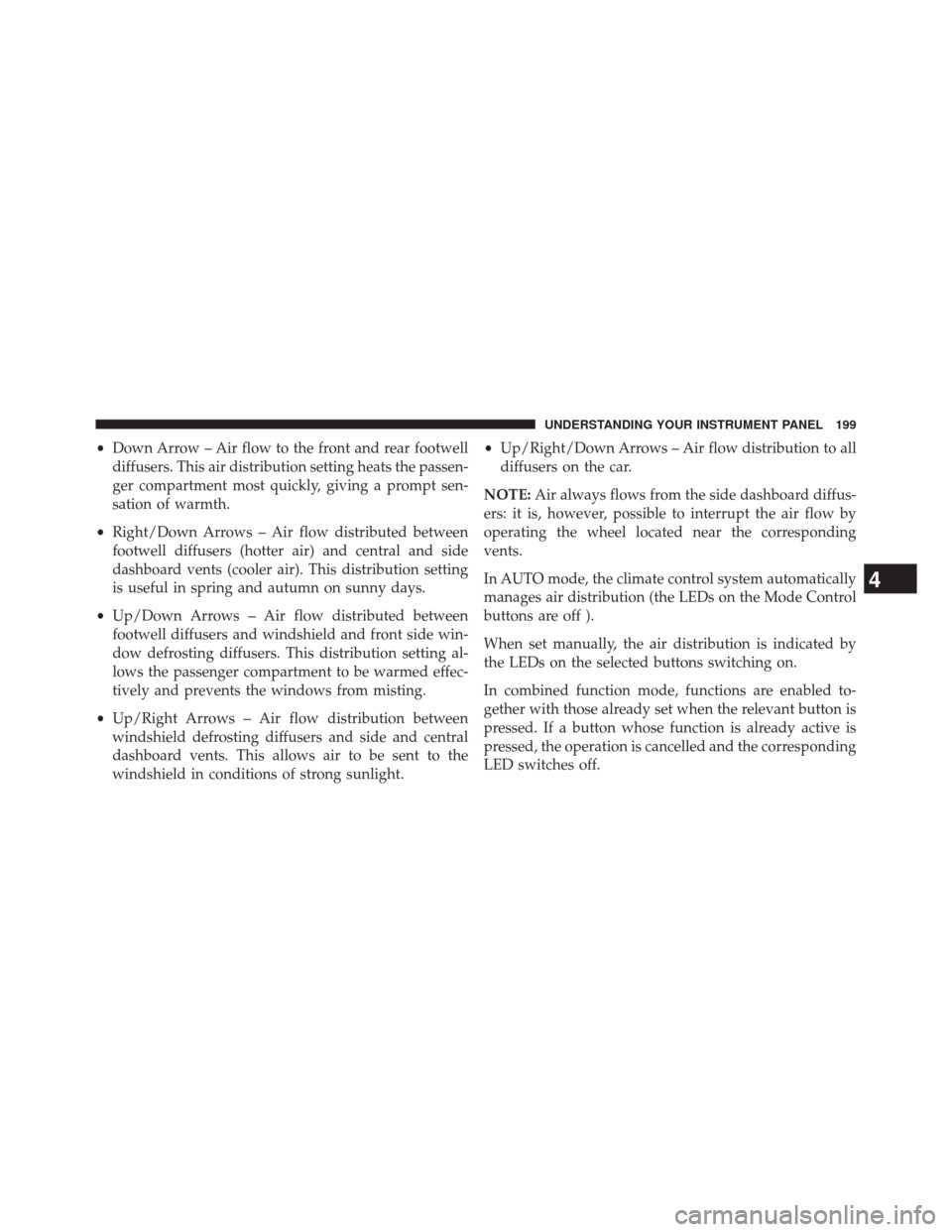Page 129 of 409
Audible And Visual Signals Supplied By The Rear Park Assist System
SIGNALMEANING INDICATION
Obstacle
Distance An obstacle is present within the
sensors’ field of view Audible signal
(dashboard loudspeaker)
• Sound pulses emitted at a rate that increases as the
distance decreases.
• Emits continuous tone at 12 in (30 cm).
• Adjustable volume level. (Refer to “Electronic Ve-
hicle Information Center (EVIC)” in “Understanding
Your Instrument Panel” for further information).
Visual signal (EVIC)
• Arcs are shown based on the obstacle’s distance and
location relative to the vehicle. (Refer to “Rear Park
Assist Display” for further information).
Failure Sensor or System failures Visual Signal(instrument panel)
• Icon appears on display.
• Message is displayed on the Electronic Vehicle Infor-
mation Center (EVIC) (where provided).
3
UNDERSTANDING THE FEATURES OF YOUR VEHICLE 127
Page 192 of 409

NOTE:Do not affix stickers to the inside of the heated
rear window over the heating filaments, to avoid damage
that might cause them to stop working properly.
Air Recirculation
Press and release the Air Recirculation button, so that the
LED on the button switch is on, to enter recirculation
mode. It is advisable to switch internal air recirculation
on while standing in traffic or in tunnels to prevent the
introduction of polluted air.
Do not use the function for a long time, particularly if
there are many passengers on board, to prevent the
windows from misting up.
NOTE: Internal air recirculation makes it possible to
reach the required heating or cooling conditions more
quickly depending on the mode selected. Do not use the
internal air recirculation function on rainy/cold days as it
would considerably increase the possibility of the win-
dows misting.
Air Distribution Selection
Rotate the Mode Control knob to manually select one of
the five possible air distribution settings in the passenger
compartment:
Air flow to the front windshield, front side win-
dow and front/rear footwell diffusers.
Air flow to the front/rear footwell diffusers. This
air distribution allows the passenger compart-
ment to be heated quickly.
Air flow distributed between central and side
dashboard vents and front/rear footwell vents.
Air flow to central/side dashboard vents (passen-
ger ’s body).
190 UNDERSTANDING YOUR INSTRUMENT PANEL
Page 200 of 409

Adjusting The Air Temperature
Rotate the Driver Temperature Control, or the Passenger
Temperature Control, dial clockwise or anti clockwise, to
adjust the air temperature in the front left (Driver Tem-
perature Control) or right (Passenger Temperature Con-
trol) zone of the passenger compartment.
The set temperatures are shown on the displays.
Press the SYNC button to align the air temperature
between the two zones.
Turn the Passenger Temperature Control knob to return
to the separate management of air temperatures in the
two zones.
Turning the control knobs completely in one direction or
the other activates the�HI�(maximum heating) or �LO�
(maximum cooling) functions respectively. To deactivate these functions, turn the temperature knob
to the desired temperature.
Air Distribution Selection
By pressing the Mode Control buttons (Up/Down/Right
arrows), it is possible to set one of the seven possible air
distributions manually:
•
Up Arrow – Air flow to the windshield and front side
window diffusers to defrost them. Use Defrost mode
with maximum temperature settings for best wind-
shield and side window defrosting. When the defrost
mode is selected, the blower will automatically default
to medium-high.
• Right Arrow – Air flow at central and side dashboard
vents to ventilate the chest and the face during the hot
season.
198 UNDERSTANDING YOUR INSTRUMENT PANEL
Page 201 of 409

•Down Arrow – Air flow to the front and rear footwell
diffusers. This air distribution setting heats the passen-
ger compartment most quickly, giving a prompt sen-
sation of warmth.
• Right/Down Arrows – Air flow distributed between
footwell diffusers (hotter air) and central and side
dashboard vents (cooler air). This distribution setting
is useful in spring and autumn on sunny days.
• Up/Down Arrows – Air flow distributed between
footwell diffusers and windshield and front side win-
dow defrosting diffusers. This distribution setting al-
lows the passenger compartment to be warmed effec-
tively and prevents the windows from misting.
• Up/Right Arrows – Air flow distribution between
windshield defrosting diffusers and side and central
dashboard vents. This allows air to be sent to the
windshield in conditions of strong sunlight. •
Up/Right/Down Arrows – Air flow distribution to all
diffusers on the car.
NOTE: Air always flows from the side dashboard diffus-
ers: it is, however, possible to interrupt the air flow by
operating the wheel located near the corresponding
vents.
In AUTO mode, the climate control system automatically
manages air distribution (the LEDs on the Mode Control
buttons are off ).
When set manually, the air distribution is indicated by
the LEDs on the selected buttons switching on.
In combined function mode, functions are enabled to-
gether with those already set when the relevant button is
pressed. If a button whose function is already active is
pressed, the operation is cancelled and the corresponding
LED switches off.
4
UNDERSTANDING YOUR INSTRUMENT PANEL 199